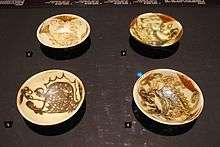Tongguan, Wangcheng
| Tongguan subdistrict 铜官街道 | |
|---|---|
| Subdistrict 街道 | |
| Country |
|
| Province | Hunan |
| Prefecture-level city | Changsha |
| district | Wangcheng |
| Area | |
| • Total | 90.3 km2 (34.9 sq mi) |
| Population (2015) | |
| • Total | 50,000 |
| • Density | 550/km2 (1,400/sq mi) |
| Time zone | China Standard (UTC+8) |
| Website | http://tgz.wangcheng.gov.cn/ |
Tongguan (simplified Chinese: 铜官街道; traditional Chinese: 銅官街道; pinyin: tóngguān jiēdào) is a subdistrict of Wangcheng district, Changsha, China. It is located on the eastern bank of Xiang river, the subdistrict is bordered by Dingziwan subdistrict to the south, Qiaoyi and Chating towns to the east and north, Jinggang town and Gaotangling subdistrict across the Xiang river to the west. Tongguan has an area of 90.3 km2 (34.9 sq mi) with a population of 50 thousand, its administrative centre is at Huacheng village. the subdistrict has 5 residential communities and 9 villages under its jurisdiction.[1]
Tongguan is a national famous tourism town with characteristic landscape published in 2015,[2] also a small town with a particular character of Hunan;[3] it was designated a famous historical and cultural town of Hunan province in 2007.[4][5]
Subdivison
The Tongguan subdistrict was formed by merging the former Tongguan town (铜官镇), Shutangshan subdistrict (书堂山街道), Guoliang (郭亮村) of Chating town and a portion of Shenjiaqiao residential community (慎家桥社区) of Dongcheng town[6] on November 19, 2015; there were 10 villages and 5 residential communities in the subdistrict at that time.[7] Tanzhou residential community was formed by merging Taifeng village (太丰村) and Hongjiazhou residential community (洪家洲社区) on March 23, 2016; the subdistrict has 9 villages and 5 residential communities[8] in 2016.
| administrative centre: Baoyong neighborhood of Huacheng (华城村保拥小区) amount of divisions: 5 residential communities and 9 villages | |||
| villages and residential communities | villages | ||
| English name | Chinese name | English name | Chinese name |
| Gaoling residential community | 高岭社区 | Heqiao village | 何桥村 |
| Shigang residential community | 誓港社区 | Huashi village | 花实村 |
| Tanzhou residential community formed at merging Taifeng and Hongjiazhou | 潭州社区 (由太丰村和洪家 洲社区合并设立) | Huacheng village | 华城村 |
| Tongguanjie residential community | 铜官街社区 | Shizhuhu village | 石渚湖村 |
| Yuanjiahu residential community | 袁家湖社区 | Shutangshan village | 书堂山村 |
| Caitaoyuan village | 彩陶源村 | Wanxing village | 万星村 |
| Guoliang village | 郭亮村 | Zhongshan village | 中山村 |
Early history
Tongguan is an ancient town with a history of over 2,100 years. There was a bridge named Wuchu (吴楚桥) at Shigang (誓港), According to legend, the bridge was at the boundary point of Wu and Chu states in the Warring States period (476–221 BC). The unearthed earthenwares at Mawangdui proved that at latest Tongguan started to produce potteries in the western Han Periods (206 BC–9 AD). The archaeological excavation at Tongguan Kiln Site showed that, the technology of underglazed color figure was originated there in the Tang (618–907 AC) and Five Dynasties periods (907–960 AC). The production of underglaze wares was once prosperous at the later Tang period, and declined in the Five Dynasties periods in the place.[9]

During An Lushan Rebellion (755 – 763 AC), the Land traffic from the North, Northwest China to the Middle East Arabdom and Persia was blocked, mean while the maritime trade was thriving in the South China. As a commercial port and one of pottery industrial centres, early in the Tang Dynasty, pottery trade between Tongguan and other areas already began, the place should be also the earliest export trade port in the history of Changsha.[9] A Tang Belitung wreck was discovered by fishermen in 1988 At Belitung island, Indonesia (Gaspar Strait). Radiocarbon dating of the ship's timber produced a relatively wide range date of 710 - 890 A.D for the wreck. the cultural relics was so-called "Tang treasure" in the salvage of the wreck, the majority of that are wares from Changsha produced in kilns in Tongguan, and the text transcript on relics used the calendar era of Tang period (618 - 907 AC). What above-mentioned is a strong evidence, as once a trade-exported port and centre of pottery production, the place of Tongguan played an important role in the history of China or Hunan.[10]
Unearthed pottery at Tang Belitung wreck
The following are the showpieces of Tang Belitung wreck at Marina Bay Sands museum, Singapore. the showpieces are the unearthed cultural relics from the wreck, the potteries made in Tongguan in Tang period.
References
- ↑ translation according to wangcheng.gov (2016-03-07)
- ↑ Tongguan was designated a National Famous Tourism town with Characteristic Landscape at third batch published in 2015 (2015-07-31) (details)
- ↑ on detail, also see sohu.com (2016-08-08), sina.com (2016-04-02) qq.com (20160406)
- ↑ historical and cultural town of Hunan province (first batch) rednet.cn (2007-6-6)
- ↑ changsha.gov (2012-06-01)
- ↑ On November 19, 2015, Guoliang village of Chating town was ajusted to Tongguan under its under jurisdiction; meanwhile there were 7 residential groups, they are Yuejin (跃进组), Ranjiang (染匠组), Hejia (禾家组), Yaojia (姚家组), Wushan (五杉组), Daguan (大官组) and Yuxin (鱼心组) from the Shenjiaqiao (慎家桥社区) residential community of Dongcheng which were merged to Huacheng village under its jurisdiction.
- ↑ See the result on adjustment of township-level administrative divisions of Wangcheng on November 19, 2015. xzqh.org: administrative division adjustment of Hunan in 2015, xinhuanet.com (2015-12-08): adjustment of township-level administrative divisions of Hunan in 2015 and people.com (2015-12-08): result in 2015 adjustment of township-level administrative division in 105 county-level divisions of Hunan
- ↑ The full result on the village-level administrative division adjustment of Wangcheng on March 2016
- 1 2 Hunan Daily (2014-05-07)
- ↑ koh-antique: Study of Chinese Ceramics in the Tang Belitung wreck
Coordinates: 28°28′42″N 112°48′17″E / 28.4782°N 112.8048°E












